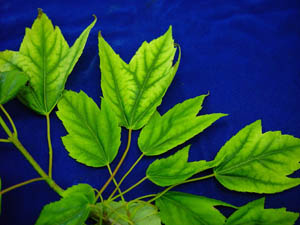Chlorosis of Trees | |
|---|---|
| June 27, 2006 | |
|
Although some parts of Illinois have recently received soaking rain, others are still experiencing drought. We have received many examples of chlorotic foliage from trees in these drought-stressed areas. Drought is not the cause of chlorosis, but it may aggravate or intensify the problem. Root injury may have occurred as a result of last year’s drought as well. Chlorosis is another word for yellowing. It usually refers to leaves or needles that are light green or yellow rather than a healthy dark green. Often, the leaf veins remain dark green while the rest of the blade is lighter in color, as shown in the maple image included.  This condition is very common in Illinois on pin oaks, silver maple, red maple, sweetgum, and birch but may occur on many other species as well. If left untreated, chlorosis can eventually lead to branch decline and death. This condition is very common in Illinois on pin oaks, silver maple, red maple, sweetgum, and birch but may occur on many other species as well. If left untreated, chlorosis can eventually lead to branch decline and death.In Illinois landscape areas, the soils typically have a high (alkaline) pH level. Where irrigation is used, the pH of the water is also an issue. City water often has a very high pH level and can influence the soil pH where supplemental watering is frequent. These higher pH soils may cause problems to trees. Minor nutrients are often tied up or bound within the soil chemistry, making them unavailable to the tree. In fact, these nutrients might be present in the soil, but they cannot be absorbed by roots. Iron or manganese are the most limiting micronutrients in a high soil pH system in Illinois. The symptoms caused by iron or manganese deficiency are very similar. Manganese deficiency is most likely if symptoms are worse on older leaves. Iron deficiency is often more a problem on new leaves first. An Illinois Extension report discussing iron and manganese chlorosis (Report on Plant Disease, no. 603, “Iron Chlorosis of Woody Plants: Cause and Control”) can be accessed at http://www.ag.uiuc.edu/%7Evista/horticul.htm or in Illinois Extension offices. Whenever roots are injured, stressed, or growing poorly, nutrient absorption is limited. Symptoms may intensify in drought or wet periods. High clay content or poorly drained soils aggravate the problem. The question is how do we treat trees that are deficient because of the pH of the soil? Start by determining the soil pH. Consult your local soil-testing lab for this service. The Plant Clinic does not test soils for nutrients or pH level. Next, determine the soil pH at which your tree thrives. Michael Dirr, in Manual of Woody Landscape Plants, often lists the desired pH for trees and shrubs discussed. Soils with a pH below 6.7 seem to be ideal pH levels for red maples. Birches thrive at a pH of 6.5 or below. Illinois landscape soils usually have a pH of about 7.4. You may have read about foliar treatments with chelated iron or manganese. Such treatments work only on leaves sprayed, so this approach is temporary and benefits only the leaves currently expanded. New leaves emerging after the spray will not turn darker green unless a more permanent solution is utilized. Adjusting the soil pH has long-lasting efficacy but is the slowest treatment in terms of plant response. This process may take several years to change the soil pH. Soil treatment is best done when the soil is moist in April, May, or early June. The amount of product used depends on soil type. Trunk injections are another option. Suggested treatment options are discussed in the fact sheet on iron chloros mentioned above. | |
| Author: | Nancy Pataky |
